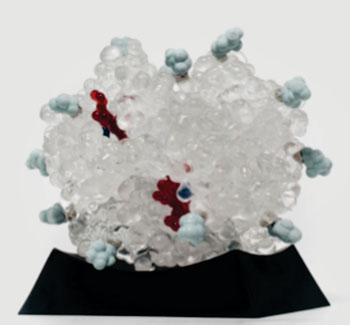Blood Obtained During Dental Treatment Suitable for Glycated Hemoglobin Determination
By LabMedica International staff writers
Posted on 10 Mar 2015
Routine visits to the dentist present an opportunity to screen for diabetes or to monitor status of glucose control for those already diagnosed with the disorder.Posted on 10 Mar 2015
A recent study confirmed that measurements of glycated hemoglobin (HbA1c) in blood samples (gingival crevicular blood or GCB) obtained from patients during dental treatment were as accurate as those conducted on classical finger prick samples.

Image: Model of a molecule of glycated hemoglobin (HbA1c) (Photo courtesy of Molecular Models, Inc.).
HbA1c is a derivative of hemoglobin that is formed nonenzymically by reaction at the N terminus of the protein molecule with glucose. In the normal adult human such derivatives constitute a few percent of the total erythrocyte hemoglobin, the most abundant being hemoglobin A1c, which increases several fold in concentration in diabetes mellitus, and is assayed to monitor control of diabetes. Once a hemoglobin molecule is glycated, it remains that way. A buildup of glycated hemoglobin within the red cell, therefore, reflects the average level of glucose to which the cell has been exposed during its life-cycle. Measuring glycated hemoglobin assesses the effectiveness of therapy by monitoring long-term serum glucose regulation. The HbA1c level is proportional to average blood glucose concentration over the previous four weeks to three months.
Investigators at the New York University College of Dentistry (NY, USA) performed HbA1c tests on 408 samples of dried gingival crevicular blood collected at the comprehensive care clinics at the New York University College of Dentistry from June 2013 to April 2014 and compared these with paired “gold-standard” HbA1c tests with dried finger-stick blood.
Results revealed a correlation of 0.991 between gingival crevicular and finger-stick blood HbA1c, and measures of concurrence between the tests were extremely high for both elevated HbA1c and diabetes-range HbA1c levels.
“Our study has considerable public health significance because we identify the value and importance of capitalizing on an opportunity at the dental visit (a) to screen at-risk, but as yet undiagnosed patients for diabetes (especially those 45 years or older) and (b) to monitor glycemic control in those already diagnosed so as to enable them to maintain their health to the greatest extent possible,” said first author Dr. Sheila Strauss, associate professor of nursing at the New York University School of Dentistry. “In light of findings from the study, the dental visit could be a useful opportunity to conduct diabetes screening among at-risk, undiagnosed patients—an important first step in identifying those who need further testing to determine their diabetes status.”
The paper appeared in the February 25, 2015, online edition of the American Journal of Public Health.
Related Links:
New York University College of Dentistry












.jpg)
